Mahoti Pattavali
Added to library: September 2, 2025

Summary
This is a comprehensive summary of the provided Jain text, the "Mahoti Pattavali," based on the content of the pages you've shared:
Book Title: Mahoti Pattavali (Great Succession Chronicle) Publisher: Somchand Dharshi Trust Author(s): While the text mentions several authors of different sections, the overall compilation and Gujarati translation are associated with the Somchand Dharshi Trust and were published under the guidance of Munishri Dhamasagarji.
Overview:
The "Mahoti Pattavali" is a significant Jain text that meticulously chronicles the succession of spiritual leaders (Acharyas and Suris) within the Anchal Gachch (also known as Vidhipaksh Gachch). This chronicle provides a detailed historical account of the lineage of these revered figures, tracing their lives, teachings, and contributions to the Jain tradition, particularly within the Anchal Gachch. The text is presented in Gujarati, making the history accessible to a wider audience.
Structure and Content:
The "Mahoti Pattavali" is structured into six main sections, each representing a continuation or addition to the historical record by different preceptors:
-
First Section (Sthiravali): This initial part is attributed to Acharya Shrimant Himavant, who composed an ancient "Sthiravali" (chronicle of elders) in the ancient Prakrit language of Magadhi. This section provides an early history of the Jain tradition, starting from Lord Mahavir and continuing up to Acharya Shridhar.
-
Second Section (Patavali): Composed by Acharya Shri Merutunga Suri, who was born in Vikram Samvat 1403 and was the 57th in the succession. This section, written in Sanskrit prose, is rich in historical facts. It details the lineage from Shuddharma Swami, the first in the line after Lord Mahavir, up to Acharya Shri Mahendra Prabh Suri, the 56th in the succession.
-
Third Section (Patavali): Authored by Acharya Shri Dharma Murti Suri, the 63rd in the succession, born in Vikram Samvat 1617. This section, also in Sanskrit, continues the historical account up to Acharya Shri Gunnindhanji, who was the 62nd in the line.
-
Fourth Section (Patavali): Written by Acharya Shri Amarsagar Suri, the 65th in the line, in Vikram Samvat 1743. This section provides an extensive description of the highly influential Acharya Shri Kalyan Sagar Suri, including detailed accounts of his life, miracles, and significant contributions. It also mentions the patronage of charitable individuals like Vardhmanshah and Paddhsinhshah of the Lalana gotra, and the great Shravaks Kurpal and Sonpal of the Lodha gotra from Agra.
-
Fifth Section (Patavali): Composed by Upadhyaya Shri Gnansagarji, a disciple of Acharya Shri Udaysagar Suri (the 66th in the succession), in Vikram Samvat 1828 in the city of Surat. This section further continues the chronicle.
-
Sixth Section (Patavali): This final section is the contemporary contribution by Muni Shri Dhamasagarji, a disciple of Muni Shri Nitisagarji, who himself was a disciple of Muni Shri Gautam Sagarji. Muni Dhamasagarji, currently active, has compiled this entire "Mahoti Pattavali" in Gujarati in Vikram Samvat 1984.
Key Themes and Content Highlights:
- Genealogy of Acharyas: The primary focus is on meticulously tracing the lineage of the Anchal Gachch's spiritual leaders, providing their names, succession order, birth and death dates (often in Vikram Samvat), and significant accomplishments.
- Historical Context: The text places the lives of these Acharyas within their historical periods, mentioning contemporary kings, political events, and social conditions. This provides valuable insights into the history of Jainism in India.
- Biographies and Miracles: The biographies include details about the Acharyas' ascetic practices, their scholarly achievements, their role in spreading Jainism, and sometimes mention miraculous feats attributed to them.
- Gachch and Gotra Information: The text delves into the origins and histories of various Jain clans (gotras) and sub-clans (shakhas or audaks) that emerged during the time of these Acharyas. It details their customs and contributions.
- Social and Cultural History: The "Mahoti Pattavali" offers glimpses into the social and cultural fabric of the time, including descriptions of prominent lay followers, their generosity, their patronage of religious institutions, and details about city developments.
- Religious Doctrines and Practices: While primarily historical, the text implicitly highlights the importance of adhering to Jain principles, asceticism, and the propagation of the faith.
- The Anchal Gachch: The text strongly emphasizes the history and importance of the Anchal Gachch, established by Acharya Aryarakshit Suri. It highlights the continuity and development of this specific lineage within Jainism.
- Gujarati Translation: The fact that the text is a Gujarati translation of earlier Prakrit and Sanskrit works makes it a valuable resource for understanding the historical development of Jain literature and its dissemination in regional languages.
Significance:
The "Mahoti Pattavali" serves as a crucial historical document for the Anchal Gachch and the broader Jain community. It offers:
- Spiritual Guidance: The lives and examples of the Acharyas provide inspiration and guidance for spiritual practice.
- Historical Research: It's an invaluable source for scholars studying Jain history, lineage, and the evolution of religious practices.
- Community Identity: The detailed chronicle reinforces the identity and heritage of the Anchal Gachch and its followers.
- Preservation of Knowledge: By translating and publishing these ancient lineages, the Somchand Dharshi Trust and associated individuals have ensured the preservation of this important historical and religious information.
In essence, the "Mahoti Pattavali" is a rich tapestry of Jain spiritual and historical narrative, meticulously woven to preserve the legacy of the Anchal Gachch's esteemed Acharyas and the communities they served.